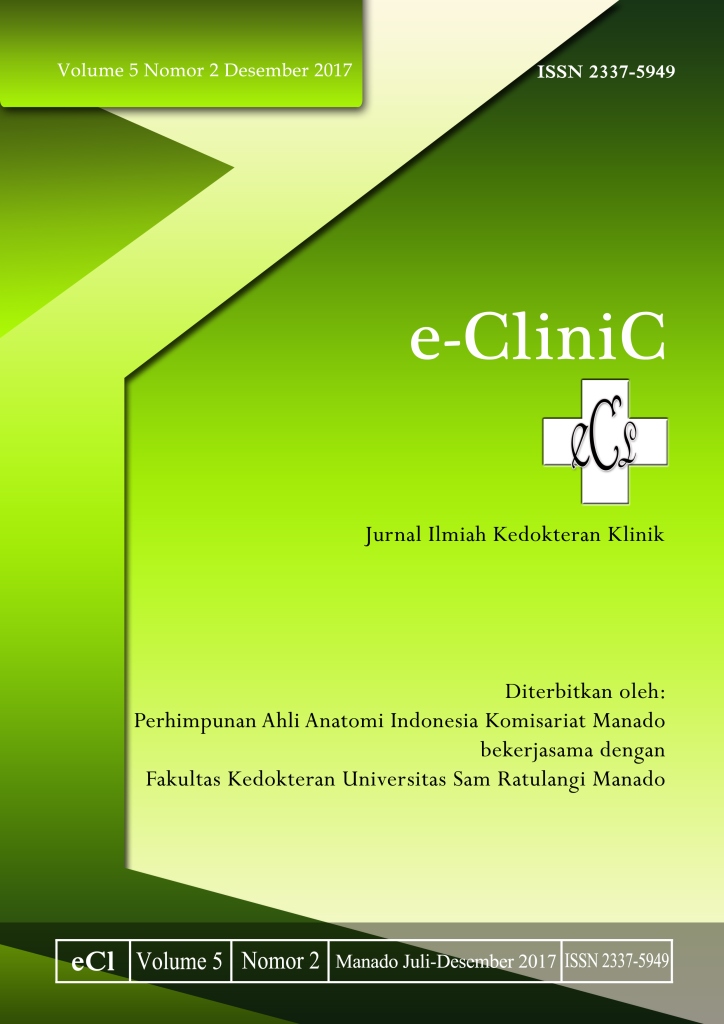Gambaran Sumber Terjadinya Infeksi pada Penderita Sepsis dan Syok Septik di ICU RSUP Prof. Dr. R. D. Kandou Manado Periode Agustus 2016 sampai dengan September 2017
DOI:
https://doi.org/10.35790/ecl.v5i2.18570Abstract
Abstract: Sepsis is defined as life-threatening organ dysfunction caused by dysregulation of host response to infection meanwhile septic shock is defined as a subset of sepsis with severe circulatory and cellular metabolism abnormalities. The incidence of sepsis has been increasing for the past three decades, and becomes the most frequent cause of death among other common diseases in the Western countries such as myocardial infarction, stroke, and trauma. This study was aimed to find out the description of infection in sepsis and septic shock patients in Intensive Care Unit (ICU) of Prof. Dr. R. D. Kandou Hospital Manado. This was a rectrospective descriptrive study. Data were obtained from the medical record of sepsis patients in the period of August 2016 until September 2017. Samples were determined by using purposive sampling method. The results showed that the source of sepsis infection and septic shock was mostly caused by pneumonia as many as 50 samples, as follows: 21 patiens (31.3%) with HAP, 11 patients with CAP (16.4%), and 18 patients with VAP (26.9%). Other sources were 8 patients (11,9%) with urosepsis, 3 patients (4.5%) with cholangitis, 2 patients (3.0%) with abscess, 1 patient (1.5%) with diabetic foot, 1 patient (1.5%) with osteomyelitis , 1 patient with decubitus ulcer, and 1 patient (1.5%) with intraabdominal infection. Conclusion: The most common source of sepsis infection and septic shock was pneumonia infection; HAP was the leading one.
Keywords: sources of infection, sepsis, shock septic
Â
Abstrak: Sepsis adalah ancaman kehidupan akibat disfungsi organ yang disebabkan oleh disregulasi respon terhadap infeksi. Syok septik adalah bagian dari sepsis dengan kelainan sirkulasi, seluler, atau metabolik yang cukup parah. Kejadian sepsis terus meningkat selama tiga dekade terakhir, dan menjadi penyebab kematian tertinggi dibandingkan penyakit-penyakit umum lainnya di negara Barat seperti miokard infark, stroke, dan trauma. Penelitian ini bertujuan untuk mengetahui gambaran sumber terjadinya infeksi pada penderita sepsis dan syok septik di Intensive Care Unit (ICU) RSUP Prof. Dr. R. D. Kandou Manado. Jenis penelitian ialah deskriptif retrospektif menggunakan data rekam medik pasien sepsis di RSUP Prof. Dr. R. D. Kandou Manado periode Agustus 2016 - September 2017. Besar sampel ditentukan dengan metode purposive sampling. Dari hasil penelitian didapatkan bahwa sumber terjadinya infeksi sepsis dan syok septik paling banyak disebabkan pneumonia (50 orang) yaitu HAP 21 pasien (31,3%), CAP 11 pasien (16,4%), VAP 18 pasien (26,9%). Sumber lainnya ialah urosepsis 8 pasien (11,9%), kolangitis 3 pasien (4,5%), abses 2 pasien (3,0%) , kaki diabetes 1 pasien (1,5%), osteomielitis 1 pasien (1,5%), ulkus dekubitus 1pasien (1,5%), dan infeksi intraabdomen 1 pasien (1,5%). Simpulan: Sumber terjadinya infeksi sepsis dan syok septik terutama disebabkan pneumonia, yang terbanyak ialah HAP.
Kata kunci: sumber infeksi, sepsis, syok septik
Downloads
How to Cite
Issue
Section
License
COPYRIGHT
Authors who publish with this journal agree to the following terms:
Authors hold their copyright and grant this journal the privilege of first publication, with the work simultaneously licensed under a Creative Commons Attribution License that permits others to impart the work with an acknowledgment of the work's origin and initial publication by this journal.
Authors can enter into separate or additional contractual arrangements for the non-exclusive distribution of the journal's published version of the work (for example, post it to an institutional repository or publish it in a book), with an acknowledgment of its underlying publication in this journal.
Authors are permitted and encouraged to post their work online (for example, in institutional repositories or on their website) as it can lead to productive exchanges, as well as earlier and greater citation of the published work (See The Effect of Open Access).







